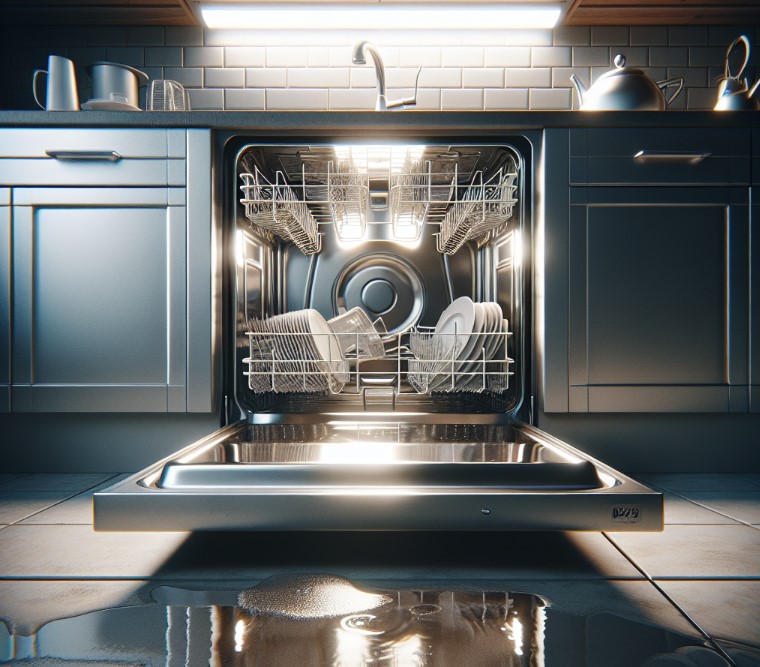A dishwasher not draining can be a frustrating issue, disrupting your kitchen routine. Understanding the intricate workings of your appliance is key to troubleshooting effectively. From the drain pump to the path water takes for drainage, various components play a crucial role. This article will delve into common causes behind your dishwasher isn’t draining fully, offering valuable insights into how to tackle and prevent such issues in the future. Stay tuned to regain the seamless functionality of your appliance.
Common Causes for Dishwasher Drainage Issues
Dishwashers are complex machines. Many things can cause drainage problems. These include clogged filters, drain hoses, and malfunctioning pumps. Improper installation can also be a reason. Identifying the issue helps fix it effectively. Various causes and solutions are as follows:
Food Particles and Debris Blockage
One of the common reasons for a dishwasher not draining properly is the blockage caused by food particles and debris. These particles can accumulate in the drain hose or at the bottom of the dishwasher, leading to clogs that hinder the drainage process.
Clogged or Incorrectly Installed Drain Hose
Clogged or incorrectly installed drain hoses are frequent culprits for a dishwasher not draining. When the drain hose is obstructed by food particles or debris, the water cannot flow out properly. Additionally, if the drain hose is not installed correctly or is kinked, it can impede the drainage process.
Faulty Drain Pump
A faulty drain pump is a common culprit when your dishwasher isn’t draining. This essential component plays a vital role in expelling water from the dishwasher during the drain cycle. If the drain pump malfunctions, water will not be pumped out effectively, leading to standing water at the bottom of the dishwasher.
Use of Incorrect Detergent
Using the wrong detergent in your dishwasher can lead to drainage issues. Some detergents create too many suds, causing water to linger in the bottom of the dishwasher instead of draining properly. These suds may also overflow and leak out of the appliance. Using detergents not designed for dishwashers can impact the rinse cycle’s effectiveness, leaving residues that contribute to clogs in the drain hose and filter. Always opt for dishwasher-specific detergents to ensure optimal performance and prevent drainage problems.
Troubleshooting Steps for a Non-Draining Dishwasher
Cleaning the Filter
To ensure your dishwasher functions properly, regularly cleaning the filter is crucial. The filter traps food particles and debris, preventing them from clogging the drain pump or drain hose. Begin by locating the filter at the bottom of the dishwasher and gently removing any accumulated residue. Rinse it under hot water to dislodge stubborn particles. This simple maintenance step can significantly improve drainage issues and enhance the overall performance of your dishwasher. Remember, a clean filter means a smoothly running dishwasher.
Inspecting and Cleaning the Drain Hose
To ensure optimal dishwasher performance, regular inspection and cleaning of the drain hose are crucial. The drain hose plays a vital role in carrying wastewater from the dishwasher to the drainage system. Over time, this hose can become clogged with food particles or debris, leading to drainage issues. By routinely examining the drain hose for blockages and cleaning it thoroughly, you can prevent potential drainage problems and maintain the efficiency of your dishwasher. Remember, a clear drain hose is key to proper water flow and drainage.
Checking the Garbage Disposal Connection
Ensure the garbage disposal connection is secure to prevent drainage issues. Inspect for any blockages or kinks in the drain hose leading to the disposal. Verify that the air gap between the dishwasher drain and disposal is clear. Run hot water through the disposal to clear any potential clogs that may hinder proper drainage. This step aids in maintaining a smooth flow of water through the system, preventing backups and ensuring your dishwasher functions effectively.
Resetting the Dishwasher
To reset the dishwasher, start by unplugging it or turning off the power at the circuit breaker. Leave it disconnected for a few minutes to allow the control panel to reset. Then, plug it back in or turn the power on and run a short wash cycle to see if the issue persists. Resetting can often resolve minor electronic glitches and bring the dishwasher back to its normal functioning. If the problem continues, further troubleshooting may be necessary.
Preventative Measures to Avoid Future Drainage Problems
Regular maintenance of your dishwasher is crucial to avoid potential issues. Here are some preventative measures to keep things running smoothly:
Regular Maintenance and Cleaning
To prevent clogs, regularly check and clean the filter, drain hose, and air gap. Wipe down the bottom of the dishwasher to remove any accumulated debris. Running hot water and a vinegar rinse cycle periodically can help maintain a clean dishwasher and prevent buildup. By staying proactive with maintenance tasks, you can ensure that your dishwasher continues to function efficiently.
Proper Installation and Use of Suitable Detergents
Correctly installing the dishwasher drain hose and ensuring a secure connection to the garbage disposal or air gap can prevent drainage issues. Additionally, using the right detergent designed for dishwashers not only promotes effective cleaning but also prevents residue buildup. Choose detergents without phosphates and avoid overfilling the dispenser to maintain the efficiency of your dishwasher. By following these steps, you can enhance the performance and longevity of your appliance.
Avoiding Hard-to-Grind Foods in the Dishwasher
Hard-to-grind foods like coffee grounds, bones, and large seeds can lead to clogs in the dishwasher drain. These foods don’t break down easily and may get stuck in the filter or drain hose, causing drainage issues. To prevent this, scrape off excess food before loading dishes, and avoid putting items that are hard to grind in the dishwasher. This simple practice can help maintain the smooth operation of your dishwasher and prevent potential drain problems.
When to Call a Professional
Signs that signal professional intervention include persistent drainage issues despite basic troubleshooting steps, water pooling at the bottom of the dishwasher, or unusual noises during the rinse cycle. If you notice water backup in the sink when the dishwasher runs, or a foul odor emanating from the garbage disposal or air gap, it might be time to seek expert assistance from Viking Appliance Repair Pros for thorough diagnosis and repair. Remember, timely professional maintenance can prevent costly repairs in the future.
Conclusion
A dishwasher isn’t draining can be a common issue many homeowners face. By understanding the importance of proper maintenance and cleaning practices, you can prevent drainage issues and prolong the lifespan of your appliance. Remember to avoid hard-to-grind foods, use the right detergent, and monitor any signs of trouble to address them promptly. If problems persist, don’t hesitate to seek professional help to ensure your dishwasher functions efficiently. Taking care of your dishwasher today will save you time and money tomorrow. Check out our blog, “Quick and Easy Viking Dishwasher Maintenance Hacks,” for more tips and tricks on keeping your dishwasher in top condition!
Frequently Asked Questions
Why does my dishwasher fail to drain even after cleaning the filter?
If your dishwasher still doesn’t drain after cleaning the filter, it could be due to a clogged drain hose or a faulty drain pump. Ensure these components are clear and functioning properly to resolve the issue.
Can a faulty drain valve cause drainage problems?
A faulty drain valve can indeed cause drainage problems in your dishwasher. If the drain valve fails to open or close properly, it can lead to water not being drained out effectively, resulting in standing water at the bottom of the dishwasher. This issue requires timely repair.
How often should I clean my dishwasher filter and hose?
To maintain optimal performance, clean your dishwasher filter monthly and inspect the hose for blockages every 3 months. Regular maintenance prevents drainage issues and ensures a hygienic wash. Follow these simple steps to keep your dishwasher running smoothly.







